Snake River Dams
Columbia River Basin
|
NEW ESRI StoryMaps: What's On Our Shelves & NWNL Song Library & No Water No Life ESRI |
Columbia River Basin
Linwood Laughy
Historian
Barbara W. Folger
NWNL Expedition Guest and Photographer
Alison M. Jones
NWNL Director and Photographer
All images © Alison M. Jones, unless otherwise noted. All rights reserved.
Lin is a Harvard graduate, Clearwater Valley resident and historian. He has observed the Snake River and its upstream tributary the Clearwater for most of his life. He and his wife, Borg Hendrickson, live a rural life on the Clearwater. When they go to “the big city,” it is Lewiston, Idaho, at the confluence of the Snake and the Clearwater Rivers.
Lin has an historical knowledge and perspective of these two river valleys. He has also studied the story of the Lower Four Snake River dams and their impacts on the Columbia River Basin’s great salmon migrations.
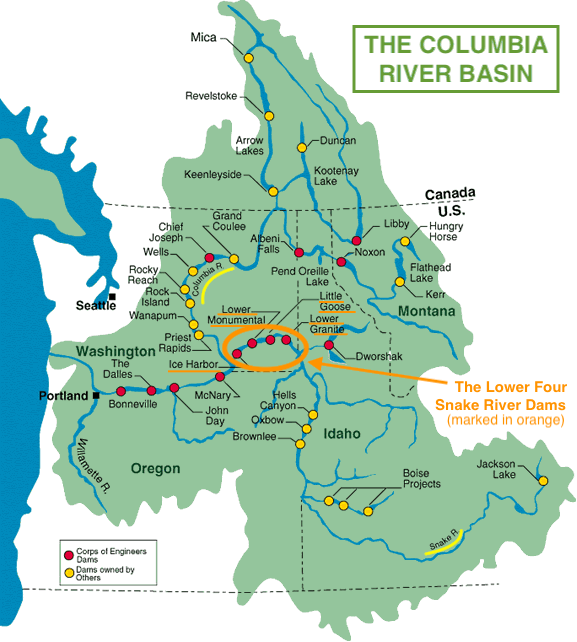
NWNL Hello Lin. It’s great to be here looking out at the Clearwater to chat with you about the Snake River and the future of its now-controversial Lower Four Dams. Will you please introduce yourself?
LIN LAUGHY I’m Linwood Laughy, often called Lin – and sometimes other names by folks who don’t appreciate what I do. I grew up just about three miles from here, having moved here with my family as a young child in 1948. I’ve observed this valley and the Clearwater River for most of my life. Thus, I have some historical knowledge and perspective of this valley, and what’s happened with the dams and the salmon.
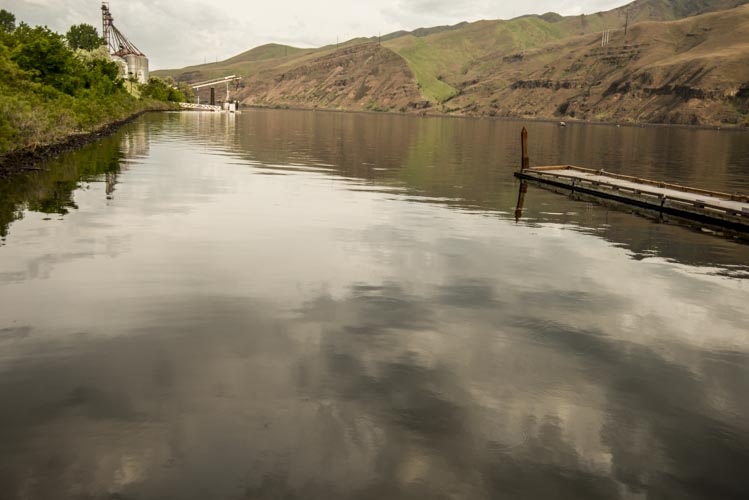
NWNL What was the initial reasoning for building the now-controversial Four Lower Snake River Dams?
LIN LAUGHY I studied the 1947 Army Corps decision to build these dams and saw that they couldn’t justify it. They kept changing, and adding this and that. In fact, Document 704 that came out before the 1947 study said, “We can’t justify it. These dams are not economically feasible.”
I thought, “Well, what about salmon? What are they going to say about salmon?” But they focused on hydropower. They said, “If we don’t build these dams and instead have to build four gas-fired power plants, it would be expensive. And so, they added hydropower to a benefit of building the dams. Nobody wanted the power, and there was no demand in 1945. The aluminum industry was closing because the war was over and so there was a surplus of power.
Back to the fish, the Corps wanted to get recreation up on the Snake. So they said, “We’ll grow millions of pounds of bass in these reservoirs.” But I was asking, “What about salmon? Idaho Fish and Game Department, the Washington Fish and Game Bureau, the Oregon Fish and Game Department, the US Fish and Wildlife Service, and some other groups said that these dams would be hazardous to salmon and other anadromous fish – and, in fact, might cause their extinction.
But the Corps didn’t believe that assessment. The Corps said that the fish were doing okay at Bonneville, so the Snake River salmon would be fine. They dismissed all of that expert testimony in one sentence, Confirmation bias.
NWNL So after that conflicted beginning, what is the status of the dams now? Is it likely they will be breached in order to allow salmon migrations to return to their spawning grounds?
LIN LAUGHY I believe, many things are changing. First of all, rail transport has become much more efficient fuel-wise than the barge traffic made possible when the four Lower Snake River dams were built. Thus, we now ship by truck, barge, and truck-rail.
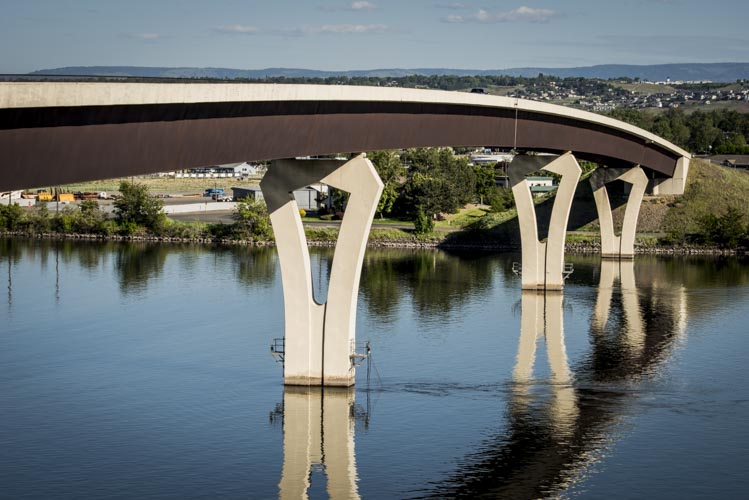
NWNL Intermodal transportation…
LIN LAUGHY Yes, intermodal transportation, dependent on site location of the rail and the river. The region’s farmers just invested $17 million for the McCoy Loader Unit so they can ship by rail, since they can get their grain to McCoy faster.
They also are reading the tea leaves. They’re smart, and they’re saying, “We’ve got an aging dam system.” For instance, we just had another emergency repair to yet another lock (at Little Goose). The locks are about 100 feet, and the dams are essentially 100 feet. According to the Army Corps of Engineers fellow I worked with (now retired), they are really pushing the limit for those locks.
A lock gate weighs about 330 tons. The original reason that they wanted to have six dams was because they weren’t sure they could handle the locks on the four dams. So, we now have costly repairs coming up and probably more interruptions in service. This series of four dams is now 60 or 70 years old now and wearing out. [Ed. Note: The average life of a dam equals the average human lifespan.]
The folks who support continued waterborne commerce on the Snake are having a difficult time. That’s why they’re falling back to the argument for hydropower. They’re pushing hydro, hydro, hydro; and they almost don’t talk about freight anymore.
There are some very entrenched special interests involved in the Lower Snake River Waterway and in hydropower. They put out propaganda – but that’s all it is. I go through it, and one of their big claims is that these dams take take 700,000 trucks off the highways every year.
The Port of Lewiston was formed in 1958 to bring real prosperity to this valley. The big promise was that water transportation was going to create an Inland Empire by shipping out all our resources. Well, it just hasn’t happened. Now the port is shifting away from waterborne commerce and to plans become a real estate development and property management group. They will argue that that shift will return huge amounts of money for every dollar of tax that is invested. Their new project will probably also turn out to be not worth a whole hell of a lot.
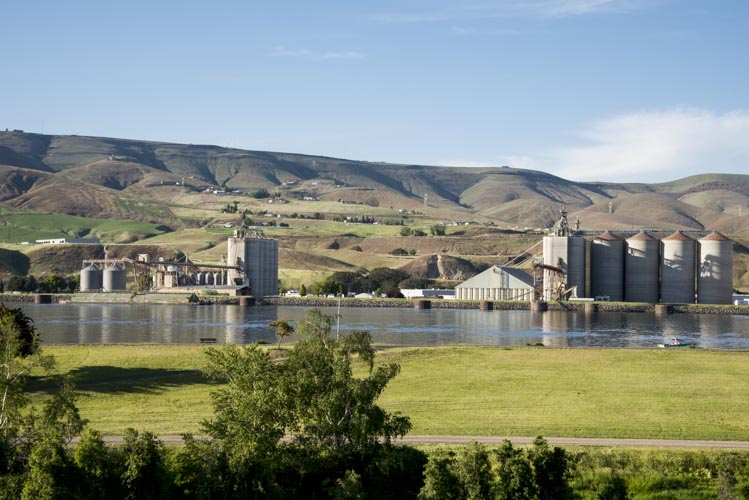
NWNL Lin, you have addressed the advantage of rail over barge, but what about the hydropower benefits the Corps keeps underlining?
LIN LAUGHY First of all, when studying the efficiency of the Lower Four Snake River Dams, you have to recognize we have a surplus of power here. Bonneville Power does not want to buy wind energy, because they have to pay a higher price for it. Wind energy has exploded, and it’s more than wiped out the capacity of the dams.
Regarding the power that’s generated, you can manipulate how much that power is worth by how you calculate the number of days that power is sold and so forth. There are days when they can’t give that power away. They give it away at zero – there’s no revenue. The amount of power being generated now is decreased by spill’s required for the fish, and that’s going to be more and more impacted by global warming. The flows are going to change, and there will be other impacts relative to sediment build up, and so forth.
But here’s my real answer to the hydro. In 2002 the Corps came out with data that said, “Oh, my gosh, breaching the dams will cost, $246 million” versus keeping the dams and hanging a lot of hardware on them to help the fish and so forth. The Congress General Accountability Office has made it very clear that the Army Corps of Engineers is expert at understating costs and overstating benefits – and that’s what they did here. What got presented to Congress and the public was that even over 20 years there’s not necessarily a lot of difference: if you breach the dams, there are costs; and if you keep them, there are costs.
NWNL What happens over the next 50 years to their cost?
LIN LAUGHY Roughly, the dams cost $300 million a year. We’re still running data, but we haven’t figured out any need for that power, or why they’re actually selling that power. If they ship power to California – which means we give up our fish – they could help irrigate golf courses in California….
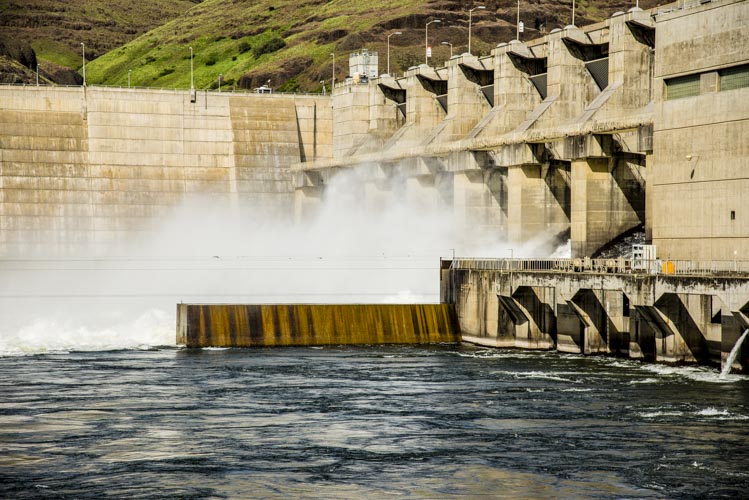
NWNL California actually needs water, and you have water – so you could swap…
LIN LAUGHY Yeah! Anyway, we don’t know yet the power value, partly because the dams’ energy supply spikes seasonally, Also, because not only are they having to do more and more maintenance —which is just natural with old systems—but they have to replace those generators. And when they start replacing those generators, it is millions, I mean, lots of millions of dollars.
So we don’t know, but we suspect that when we get this data fully analyzed, the answer may not be that, “We can’t afford to breach the dams.” It may be that we can’t afford to keep them.
NWNL What are the long-term costs even if the dams are breached? One study – I think it may have been in 2002 by NOAA – said that even if the dams were breached, they would still have to keep all the fish hatcheries operating.
LIN LAUGHY There are two kinds of fish hatcheries. Some are just “salmon ranches,” spending a lot of money sending salmon out to sea and hoping a few come back so that fishers can catch them.
NWNL You’re talking about recreational salmon.
LIN LAUGHY Yes, and commercial salmon. The other kind of hatchery restores traditional salmon runs. For example, the Nez Perce hatcheries don’t raise salmon in tanks and then turn them loose in the river. They take them when very young up to natal streams. We certainly would want to continue to have those kinds of hatcheries. But it’s really a complicated issue and we’re still working on it.
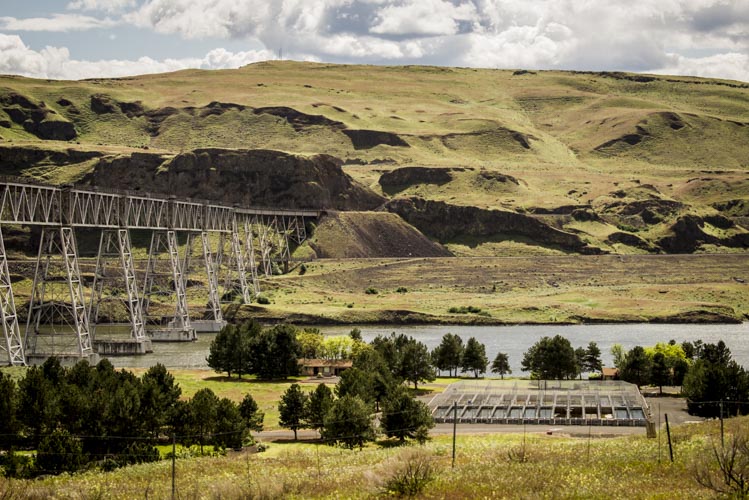
NWNL Our research has revealed that the Brownlee Dam has a terrible sludge with methyl mercury at the bottom, because the septic tank hasn’t worked as well as it should.
LIN LAUGHY Nobody should eat the fish out of Brownlee.
NWNL I imagine the sediment that’s built up behind these dams is going to contain mercury pollution in the air that has fallen to the bottom of the dam reservoirs and turned into methyl mercury. So, when the dams are taken down, they will be hazardous waste sites.
LIN LAUGHY Well, of course. They have been drilling down into the sediment. They will dredge this winter (a cost of $6.5 million) as part of the $16 million (and growing) study on sediment.
The Lower Snake has a unique and big sediment drop. The Salmon River tributary produces about 60% of the sediment.
NWNL Do we know why?
LIN LAUGHY Fires are a factor, but actually, it’s mostly because it’s just a big watershed. The Clearwater River, the Grand Ronde and some of the Snake below the dams all contribute polluted sediment. Think about how the Snake and the Clearwater come down here and then, all of a sudden, hit slack water and make a 90-degree turn. Boom! Sediment drops out.
We have this huge sediment trap. So now there’s this big problem, and it’s going to get worse, because of forest fires. Sediment is going to increase.
Look at the Sediment Plan they have. They assess forest fires by decades—the ‘70s, ‘80s, ‘90s, so forth. Roughly speaking, every decade there are huge increases in forest fires and the number of acres burned. Huge. But the Corps has been making all their plans as if sediment is going to remain constant. Well, it’s not, because when you get forest fires, you get sediment.
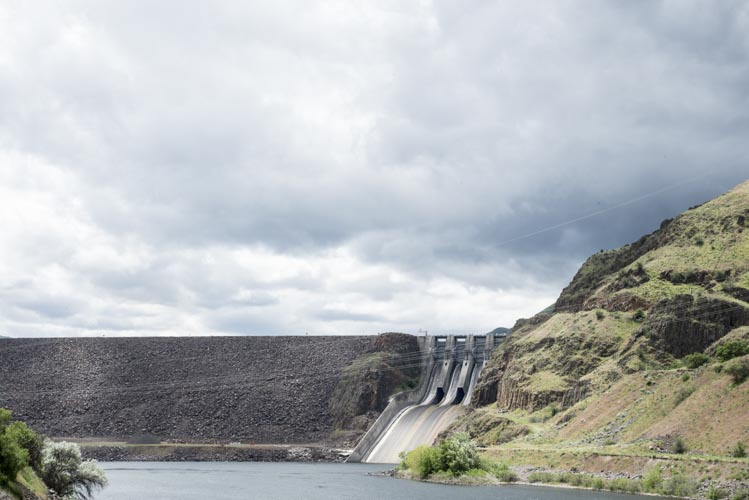
NWNL What are the answers and liabilities regarding this huge “sediment drop?”
LIN LAUGHY Well, removing sediment on an annualized basis, costs $800,000. That includes down the Snake toward the Port of Clarkson. Most of it is attributable to Port Lewiston, which they haven’t dredged in eight years. They say it’s going to cost about $6.5 million, or $812,500 annually. I say, “Let’s look at the whole history of dredging which includes 23 years of records on dredging. How much does that add up to per year over the whole history of dredging?”
The cost of dredging approximately 177,000 cubic yards in 2005/06 (without inflation) was approximately $1,275 a yard, The annualized cost: $2.2 million – just for dredging. That’s a little different. Then if we amortize the $16 million that they’ve spent in planning for dredging, over maybe 20 years, you add another $800,000. That’s very expensive.
The port says it pays to have a port. No, it costs to have a port. It costs a lot of money to have a port. In 2002, they wanted to dredge again, and some folks said, “Wait a minute, you can’t just keep dredging like this. You need a plan, an overall plan for managing sediment.” So, they came up with it a year ago, after eight years and $16 million.
NWNL What was in that plan and what is happening now?
LIN LAUGHY Their plan was full of holes and so easy to challenge. Our comments were 22 pages. So they didn’t go ahead with it, probably because they knew they would have to go to court, and they would lose, just like they did in 2002. The dredging in 2005 and 2006 was kind of a compromise.
So now they’re going to try to dredge again. They’ll claim an emergency, or something. I don’t know what they’re going to do, but they’ll come out in June or July with a final Environmental Impact Study. Based on what I read a year ago, they’ll probably go to court, and they’ll probably lose.
NWNL What has been the impact of forest fires? I think the amount of acreage burned in 2012 equaled the total of the previous decade’s worth. Fires are increasing as a result of climate change. Has that been included in the predictions? Because that increases erosion and thus sedimentation.
LIN LAUGHY Well, the Corps’ modelling on sediment was based on a continuation of the same levels of sediment – but that’s not likely. In fact, one of the scientific papers in their Appendix said sediment amounts could increase by up to ten times due to climate change. Now suppose it’s just two times or three times. Just that’s a huge problem
Sediment’s going to increase for a number of reasons. There are a huge amount of fires going on, and fires create erosion in two ways. First, when the forest is gone, you don’t have tree roots holding soil in place, so you get natural “surface erosion.” But you also get “mass failures,” when a whole hillside slumps. Then, of course, that slumps into a creek, and then into the next stream and the next stream and into the river. So, we’re going to have significant increases in sediment.
The second variable they predict is that we will have more storm events, especially in the spring. That means more flooding and more runoff. The weather, as we see all over the country now, is getting much more erratic, and that’s liable to produce more sediment as well.
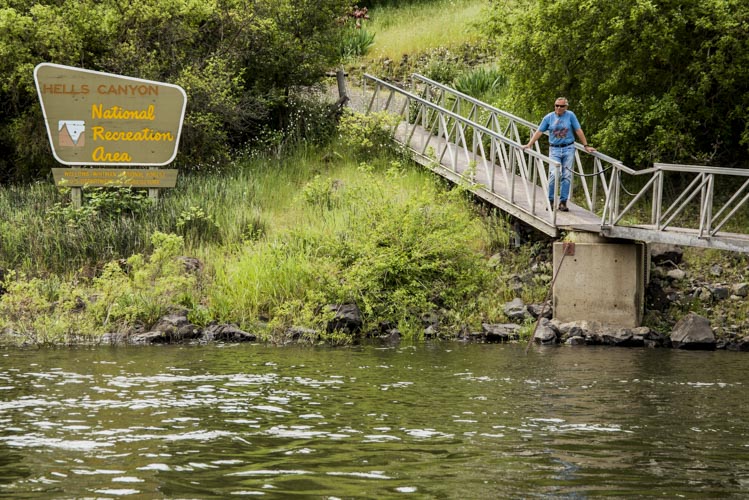
NWNL What other impacts does climate change have to this Snake River system?
LIN LAUGHY Climate change will probably heat up the water in those reservoirs. It’s already creating a significant problem for the most endangered salmon: the sockeye, the redfish and the lake sockeye. Higher water temperature last year created a “thermal block” that the fish wouldn’t go through. So now the Corps must up with some method to get cooler water for the fish.
Every time you raise that water temperature, you get more disease in the fish. One of the rivers last year – either the John Day or the Tucannon – lost about half their salmon because the water temperature was too high. So somehow the Corps has to plan for this.
NWNL Evidently, a lot of the salmon are bypassing the Tucannon.
NWNL Because of the global population explosion, we’ll need more food. Thus, many farmers are saying, “You need us; therefore, we need water.” Will they get as much, or more water, from these dams that are run-of-the-river dams – not holding dams.
LIN LAUGH Yeah, but only for 13 farms. Almost all the wheat that goes down the river from here is dry-land farming. Those 13 farms produce literally only a drop in a very large bucket of wheat, so providing dams for them seems to me kind of weak.
NWNL Some say those 13 irrigators get the best deal and all the benefit of the dammed water.
LIN LAUGH Beyond the benefit of getting water, they don’t have to pay very much to get it lifted to their fields. The original justification for the dams said they would irrigate 132,000 acres. Well, they’ve not even to irrigated 35 acres after about 50 years. So that was another inflated figure, to justify the dams.
We also have to remember that the dams flooded approximately 19,000 acres, some of which was farmland. Some of that was beach land. When I was a kid, I’d go down with my parents to get peaches. There were beautiful peach farms down below Clarkston on beaches along the river. But that’s all flooded – as is the riparian zone. The Washington Department of Fish and Game did a big study on the riparian zone and the amount of deer, quail and others game it originally held. The dams just wiped them out. Unfortunately, you can’t go up on a bluff and create a riparian zone. It just doesn’t work.
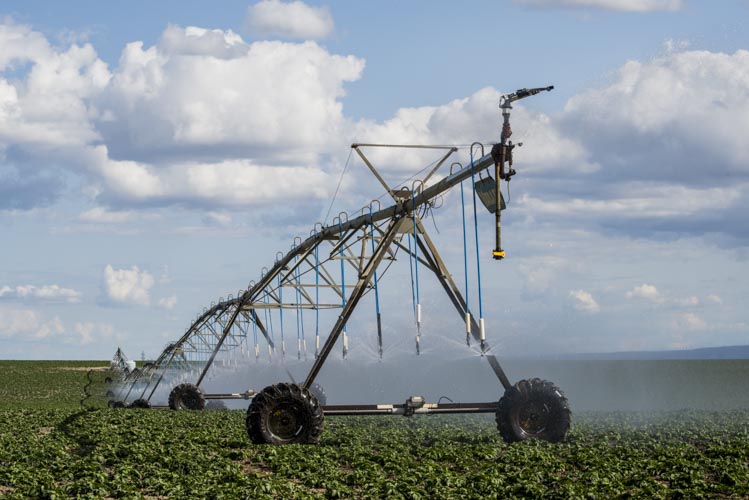

NWNL Beyond economic costs, what about damages to emotional and long-standing ties to the region’s natural resources? I’m thinking particularly of the historic and native lifestyles of the Nez Perce and other indigenous tribes. They have such a strong tradition of living with nature. So many of us non-tribal members lack that, so how do we best address those moral issues?
LIN LAUGH I’m glad you mentioned that, because thus far we’ve been talking pure economic costs. There have been other huge, huge costs. Coastal communities used to have 16 times as many salmon as they do now. Severe social disruptions occurred when that fishing industry collapsed. Think of all the animals that used to live in those now-flooded riparian zones and a further 20,000+ acres. The Nez Perce keep saying that someone needs to speak for the animals.
When we talk about Nez Perce culture, I think very few non-native Americans understand their losses, the depth of their spiritual feelings about their land, or the role that salmon played in their life, economically and spiritually. You know, the doves would coo in the spring announcing that the salmon were coming, and when those first salmon arrived, it was a message that everything was okay – that life was as it should be.
I’ve studied Nez Perce culture a lot, and I’ve lived with native people. I spent six years with the Yupik Eskimo people near the Bering Sea. They have a whole different system of thinking. I almost get angry that we white men and women only look at economic costs.
Today we are seeing an unusual convergence of Native Americans, environmentalists and economic conservatives, including the Tea Party, fighting the Corps this giant federal agency that is spending a lot of our money, and having negative results.
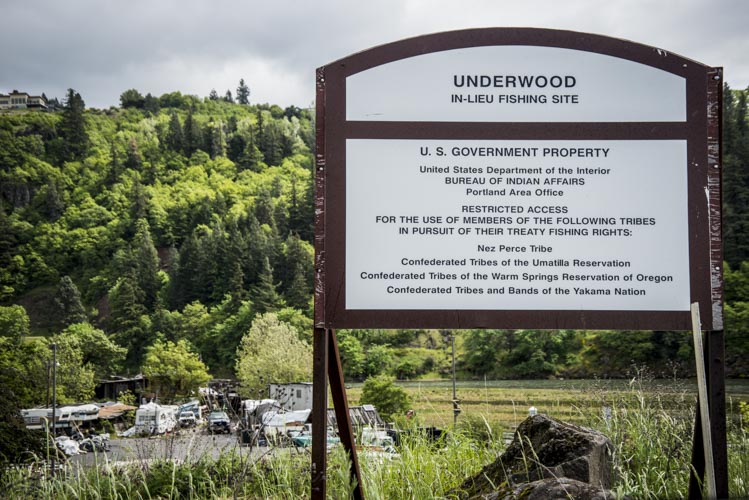
NWNL is there a possibility of breaching these four dams at this point?
LIN LAUGH Folks have been butting their heads against those dams for 20 years, and they’re still there. We have an aging system that’s going to require a lot more investment and provide more uncertainty to shippers. We need a new flank, and that’s economics. That’s why I’m involved with that coalition of folks.
NWNL Where in the economic sector do you see a chance for doing away with the dams?
LIN LAUGH We have some changes in agriculture going on. Farmers up on the Palouse used to grow just soft, white wheat that went to Asian markets. Well, now they’ve found that they can grow four of the five kinds of wheat, and hard red winter wheat. Some of these other wheats are for our domestic market, so they go east – not downstream on the Columbia System to the Pacific Ocean.
There’s also the rise of the garbanzo. Along with lumber and pulp, crops of peas, lentils, and garbanzos (chickpeas) have been traditionally barged downstream. Now, because of the growing US hummus market, they’re growing a lot more garbanzos. Acreage on the Palouse in garbanzos has gone from 20,000 acres to 150,000 acres. Since most hummus processing is on the East Coast, that too goes east by rail or truck – not by barges, towards the Pacific.
We also have increased rail efficiency leading to rail taking more and more of the market. The new McCoy Unit Loader can handle 20 million bushels. The whole prairie up there only grows 50 million bushels, so now 1 of every 2 bushels of grain from the Palouse is probably going to go through the McCoy Loader Unit. All of these things are reducing the need for barges on the Lower Snake.
So I think now’s the time, even though many don’t quite see the glimmer of hope that is emerging. A lot of it’s just changing economics.
NWNL I agree with you about economics being a key driver. Wolves got reintroduced, since they bring in tourism money. Dollars make a difference.
Yet I remember Bill Layman, a historian in Wenachee saying to me in 2007, “If you’re going to study this river system, be prepared to grieve.” So, this morning I shared that comment with Rebecca Miles, former Nez Perce Chief. I asked whether she could envision a Snake River era beyond grief. Can you, Lin?
LIN LAUGH Wonderful question. What did Rebecca say? I get emotional at times when it comes to Native Americans.
NWNL She said the dams caused a dismemberment from the river for the Nez Perce but now they are trying to remember what the river used to mean, so they can repair it. I feel more and more people seem to be telling us that people will come together. What’s your sense?
LIN LAUGH Some of us are impatient vultures. Recall the cartoon where the two vultures are sitting on a limb and looking out over the desert, and one says to the other one, “Patience, my ass. I’m going to kill something.” We’re impatient. I’m not young. I don’t have a lot of years left to impact those dams, so I’ve got to be doing something to make breaching happen soon.
For the next five years, there’s going to be litigation over the BiOP [Biological Opinion by NOAA Fisheries.] I don’t know what’s going to happen to the fish, but I think the impacts of climate change will have significant impacts. I think the next five years will see a renewed interest in, and questioning of, the value of the Lower Snake River dams, due to the many changes occurring in agriculture.
While breaching the dams might cost $10 million or $20 million, we plan on actively pursuing that. We’re not pursuing further study. We think the studies have been done. We just need the right numbers, the corrected numbers. We’re not interested in, “You know, well, like I say, you know, some people say we need more study, you know….” No. No. We just need to breach them, flat out.
Do it.
NWNL Lin, thank you so much for sharing your insights and opinions on this critical issue.
Posted by NWNL on November 13, 2019.
Transcription edited and condensed for clarity by Alison M. Jones.
All images © Alison M. Jones, unless otherwise noted. All rights reserved.
